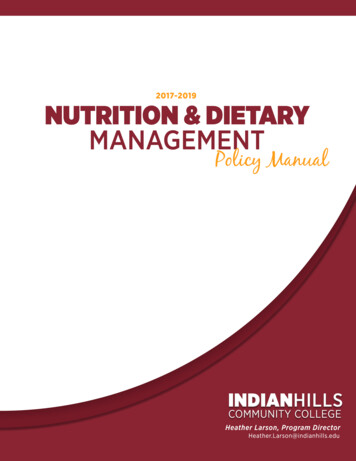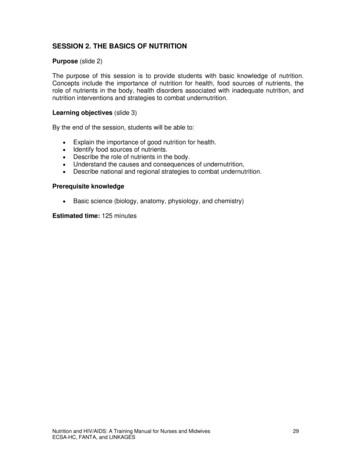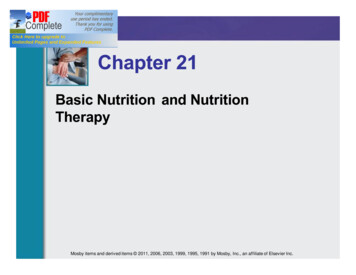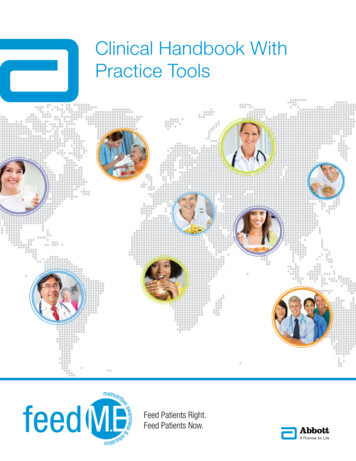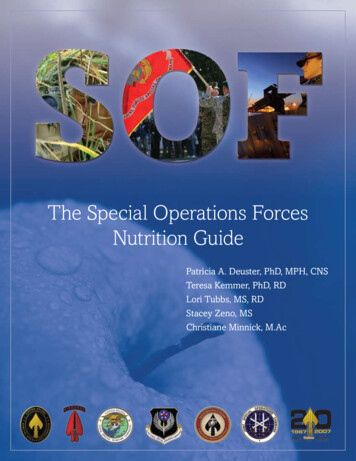
Transcription
Final PDF to printerWardlaw’sPERSPECTIVES INNutritionUpdated with 2015–2020 Dietary Guidelines for Americans
Final PDF to printer
Final PDF to printerWardlaw’sPerspectives inUpdated with 2015–2020 Dietary Guidelines for AmericansCAROL BYRD-BREDBENNERRutgers, The State University of New JerseyGAILE MOESeattle Pacific UniversityJACQUELINE BERNINGUniversity of Colorado at Colorado SpringsDANITA KELLEYWestern Kentucky University
Final PDF to printerWARDLAW’S PERSPECTIVES IN NUTRITION Updated with 2015-2020 Dietary Guidelines for Americans,TENTH EDITIONPublished by McGraw-Hill Education, 2 Penn Plaza, New York, NY 10121. Copyright 2016 by McGraw-Hill Education. All rights reserved. Printed in the United States of America. Previous editions 2013, 2009, and 2007. No part of this publication may be reproduced or distributed in any form or by anymeans, or stored in a database or retrieval system, without the prior written consent of McGraw-Hill Education,including, but not limited to, in any network or other electronic storage or transmission, or broadcast fordistance learning.Some ancillaries, including electronic and print components, may not be available to customers outside theUnited States.This book is printed on acid-free paper.1 2 3 4 5 6 7 8 9 DOW 21 20 19 18 17 16ISBN 978-1-259-91837-7MHID 1-259-91837-8Senior Vice President, Products & Markets: Kurt L. StrandVice President, General Manager, Products & Markets: Marty LangeVice President, Content Design & Delivery: Kimberly Meriwether DavidManaging Director: Michael HackettBrand Managers: Amy Reed/Marija MagnerDirector, Product Development: Rose KoosDirector of Digital Content: Michael G. Koot, PhDProduct Developer: Darlene M. SchuellerMarketing Manager: Kristine RellihanDigital Product Analyst: Christine CarlsonDirector, Content Design & Delivery: Linda AvenariusProgram Manager: Angela R. FitzPatrickContent Project Managers: MaryJane Lampe/Brent dela CruzBuyer: Jennifer PickelDesign: Matt BackhausContent Licensing Specialists: Lori Hancock/Lorraine BuczekCover Image: Adrianna Williams/CorbisCompositor: SPi GlobalPrinter: R. R. DonnelleyAll credits appearing on page or at the end of the book are considered to be an extension of the copyright page.Library of Congress Cataloging-in-Publication DataNames: Wardlaw, Gordon M. Byrd-Bredbenner, Carol. Moe, Gaile. Berning,Jacqueline R. Kelley, Danita S.Title: Wardlaw’s perspectives in nutrition.Other titles: Perspectives in nutritionDescription: Tenth edition, updated with 2015-2020 dietary guidelines forAmericans / Carol Byrd-Bredbenner, Rutgers, The State University of NewJersey, Gaile Moe, Seattle Pacific University, Jacqueline Berning,University of Colorado at Colorado Springs, Danita Kelley, WesternKentucky University. New York, NY: McGraw-Hill Education, [2016] Includes bibliographical references and index.Identifiers: LCCN 2016009387 ISBN 9781259918377 (alk. paper)Subjects: LCSH: Nutrition.Classification: LCC QP141 .W38 2016b DDC 612.3—dc23 LC record available at http://lccn.loc.gov/2016009387The Internet addresses listed in the text were accurate at the time of publication. The inclusion of a websitedoes not indicate an endorsement by the authors or McGraw-Hill Education, and McGraw-Hill Education doesnot guarantee the accuracy of the information presented at these sites.www.mhhe.com
Final PDF to printerBrief ContentsPART 11234PART 25678PART 391011PART 412131415PART 5161718NUTRITION BASICSThe Science of Nutrition 2Tools of a Healthy Diet 38The Food Supply 72Human Digestion and Absorption 116ENERGY-YIELDING NUTRIENTS AND ALCOHOLCarbohydrates 154Lipids 190Proteins 226Alcohol 260METABOLISM AND ENERGY BALANCEEnergy Metabolism 284Energy Balance, Weight Control,and Eating Disorders 318Nutrition, Exercise, and Sports 364VITAMINS AND MINERALSThe Fat-Soluble Vitamins 402The Water-Soluble Vitamins 438Water and Major Minerals 488Trace Minerals 540NUTRITION APPLICATIONS IN THE LIFE CYCLENutritional Aspects of Pregnancy and Breastfeeding 576Nutrition during the Growing Years 616Nutrition during the Adult Years 656v
Final PDF to printerMeet the Author TeamC a r o l B y r d - B r e d b e n n e r, P h . D . , R . D . , FA N D , received her doctorate fromPennsylvania State University. Currently, she is Professor in the Nutritional Sciences Department atRutgers, The State University of New Jersey. She teaches a wide range of undergraduate and graduatenutrition courses. Her research interests focus on investigating environmental factors that affect dietarychoices and health outcomes. Dr. Byrd-Bredbenner has authored numerous nutrition texts, journalarticles, and computer software packages. She has received teaching awards from the AmericanDietetic Association (now called the Academy of Nutrition and Dietetics), Society for NutritionEducation, and U.S. Department of Agriculture. She was the recipient of the American DieteticAssociation’s Anita Owen Award for Innovative Nutrition Education Programs. She also was a Fellowof the United Nations, World Health Organization at the WHO Collaborating Center for NutritionEducation, University of Athens, Greece. She enjoys exploring food and culinary customs, traveling, diving, and gardening.G a i l e L . M o e , P h . D . , R . D . , earned a doctorate in nutritional sciences at theUniversity of Washington. She is a registered dietitian who has worked in clinical nutrition,research, and management, as well as education. She is currently Professor and Directorof the Didactic Program in Dietetics at Seattle Pacific University. She has published inpeer-reviewed journals in the areas of nutrition and cancer and media reporting of nutritionresearch. Gaile enjoys swimming, cycling, walking, and hiking, along with learning aboutculinary traditions, food, and food policy.J a c q u e l i n e R . B e r n i n g , P h . D . , R . D . , C S S D , earned her doctorate in nutritionfrom Colorado State University in Fort Collins, Colorado. She is currently Professor andChair of the Health Science Department at the University of Colorado at Colorado Springs(UCCS), where she has won numerous teaching awards. Dr. Berning is published in thearea of sports dietetics and was the sport dietitian for the Denver Broncos for over 25 years,Cleveland Indians for 18 years, and Colorado Rockies for 10 years. Currently she is the sportdietitian for UCCS athletics and US Lacrosse. She is active in the Academy of Nutrition andDietetics, where she served as the chair of the Program Planning Committee for FNCE andis currently Chair of the Appeals Committee. In 2014, Dr. Berning was awarded the MaryAbbot Hess Award for Culinary Events for teaching the University of Colorado football teamhow to grocery shop and cook. Additionally, she served 6 years as an ADA spokesperson andis a former chair of the Sports, Cardiovascular, and Wellness Nutritionists dietetics practicegroup. She enjoys walking, hiking, and gardening.D a n i t a S a x o n K e l l e y, P h . D . , R . D . , earned her doctorate in nutritional sciencesfrom the University of Kentucky. She serves as Associate Dean of the College of Health andHuman Services and is a Professor in the Family and Consumer Sciences Department atWestern Kentucky University. Previously, Dr. Kelley was Director of the Didactic Programin Dietetics at Western Kentucky University. She is a Past President of the Board of Directorsfor the Kentucky Academy of Nutrition and Dietetics. Her scholarly work has focusedon healthy eating of adolescents, communication skills of dietetic students, histaminergicactivity and regulation of food intake, and dietary restriction effects on the antioxidantdefense system. She has received awards for teaching from the Kentucky Academy ofNutrition and Dietetics and the Dietetic Educators of Practitioners of the Academy ofNutrition and Dietetics. She enjoys singing, walking her dog, cheering for her family inwater-ski competitions, and watching her children participate in athletic and musical endeavors.vi
Final PDF to printerPrefaceition ofdEd withhettnaedTpeUhtnoWelcome t erspectives in Nutritio mericansPs for A providing an accurate, denlieidWardlaw’suGreon oftaryiee endeavoDed reputati0rve2se0dion. We havly2ithrs.trc–utorinc5feuo1trthslds0in2andmic fieition haatstrnnuyedNdetuinsthsethtoctivnt toonr boPerspedition foommitmeintroductiWardlaw’sching this e nt learning, and our cthoughtfulridnnead usy,bthepcestudeents, guidexcellendetetufosomdcurrent, in-dnnroioapitdrsbeenuctosire toon this tray that havegenuine dets from instrhrnpueooto build upsm,nmiloohiocitpvendd then for nutrcontent anh constructistrengths aiteecwnthdOur passioieinlecpstaueinoaccuracy, cssibility of ths been to mscientific ace the acceary goal hanmarihpnreutoO.eurin this effortmany othek yet continof this boo, as well asdents.rsturksothisath’stouyllmaaarsdheetheFor thur carey.als for iall of our live compelling reason foly affects aometimes csdendrthunfoisfo(asroisenvpothtiti,aNutritionits implicad cliniciansand provocunderstandarchers, ann researchedsnioaitretr,hattention inursrcnaftoeoaseductest reater or lessid pacelarepgeraethefrvhoeTts.seldstay abreau believe ddynamic fiepics that yonge us all totollesauhchsitgwfindinshareinvite you tohealth. Weition.the next edalth!To your heer-BredbennCarol ByrdGaile MoeBerningJacquelineyDanita Kellevii
Final PDF to printerPersonalized,Adaptive LearningMcGraw-Hill LearnSmart is one of the most effective andsuccessful adaptive learning resources available on themarket today. More than 2 million students have answeredmore than 1.3 billion questions in LearnSmart since 2009,making it the most widely used and intelligent adaptivestudy tool that’s proven to strengthen memory recall,keep students in class, and boost grades. Students usingLearnSmart are 13% more likely to pass their classes and35% less likely to drop out.LearnSmart continuously adapts to each student’s needsby building an individual learning path so students studysmarter and retain more knowledge. Turnkey reportsprovide valuable insight to instructors, so precious classtime can be spent on higher-level concepts and discussion.Fueled by LearnSmart—the most widely used andintelligent adaptive learning resource—SmartBook is thefirst and only adaptive reading experience available today.Distinguishing what students know from what they don’t,and honing in on concepts they are most likely to forget,SmartBook personalizes content for each student in acontinuously adapting reading experience. Reading is nolonger a passive and linear experience but an engagingand dynamic one where students are more likely to masterand retain important concepts, coming to class betterprepared. Valuable reports provide instructors insight intohow students are progressing through textbook contentand are useful for shaping in-class time orassessment.As a result of the adaptive reading experiencefound in SmartBook, students are more likely toretain knowledge, stay in class, and get bettergrades.viii“LearnSmart has helped me to understandexactly what concepts I do not yet understand.I feel like after I complete a module I havea deeper understanding of the material anda stronger base to then build on to apply thematerial to more challenging concepts.”Student
Final PDF to printerDigital efficacy study shows results!Digital efficacy study final analysis showed students experience higher success rates when required to use LearnSmart. Passing rates increased by an average of 11.5% across the schools and by a weighted average of 7% across all students. Retention rates increased an average of 10% across the schools and by a weighted average of 8% across all students.Study Details The study included two state universities and four community colleges. Control sections were assigned chapter assignments consisting of testbank questions, and the experimental sections wereassigned LearnSmart, both through McGraw-Hill Connect . Both types of assignments were counted as a portion of the grade, and all other course materials and assessments wereconsistent. 358 students opted into the LearnSmart sections and 332 into the sections where testbank questions were assigned.“After collecting data for fivesemesters, including two 8-weekintensive courses, the trend wasvery clear: students who usedLearnSmart scored higher on examsand tended to achieve a letter gradehigher than those who did not.”Gabriel GuzmanTriton Collegeix
Final PDF to printerConnecting Instructorsto StudentsSaves students and instructors time while improving performanceMcGraw-Hill Connect Nutrition is a digital teaching and learningenvironment that saves students and instructors time while improvingperformance over a variety of critical outcomes. Auto-grade assessments and tutorialsInstructors can easily create customized assessments that will be automatically graded. All Connect content is created by nutrition instructors, so it ispedagogical, instructional, and at the appropriate level. Interactive questions using high-quality art from the textbook and animations and videosfrom a variety of sources take students way beyond multiple choice. Gather assessment informationAll Connect questions are tagged to a learning outcome, specific sectionand topic, and Bloom’s level for easy tracking of assessment data. Access content anywhere, anytimeThe media-rich eBook allows students to do full text searches, add notesand highlights, and access their instructor’s shared notes and highlights. Streamline lecture creationPresentation tools, such as PowerPoint lecture outlines, including art,photos, tables, and animations, allow instructors to customize theirlectures.McGraw-Hill Connect Insight is a powerful data analytics tool that allows instructors to leverage aggregated informationabout their courses and students to provide a more personalized teaching and learning experience.x
Final PDF to printerand Students toCore ConceptsLearnSmart Prep is designed to get students ready for a forthcoming course by quicklyand effectively addressing prerequisite knowledge gaps that may cause problems downthe road.McGraw-Hill Campus integrates all of your digital products from McGraw-Hill Education with your school’s Learning Management System for quick and easy access to best-in-class content and learning tools.Dietary Analysis ToolNutritionCalc Plus is a suite of powerful dietary self-assessment tools that help studentstrack their food intake and activity and analyze their diet and health goals. Students andinstructors can trust the reliability of the ESHA database while interacting with a robustselection of reports.Presentation Tools allow you to customize your lecturesEnhanced Lecture Presentations contain lecture outlines, art, photos,tables, and animations. Fully customizable, complete, and ready touse—these presentations will streamline your work and let you spendless time preparing for lecture!Editable Art Fully editable (labels and leaders) line art from the text.Animations Over 50 animations bring key concepts to life, availablefor instructors and students.Animation PPTs Animations are truly embedded in PowerPoint forultimate ease of use! Just copy and paste into your custom slideshowand you’re done!Digital Lecture CaptureTegrity is a fully automated lecture capture solution used in traditional, hybrid,“flipped classes” and online courses to record lessons, lectures, and skills.xi
Final PDF to printerConnecting Students toToday’s NutritionOur Intended AudienceThis textbook was developed for students pursuing nutrition and health science careers aswell as those wanting a better understanding of how nutrition affects their lives. Becausethis course often attracts students from a broad range of majors, we have been careful toinclude examples and explanations that are relevant to them and to include sufficient scientific background to make the science accessible to them. The appendices help studentswho wish to learn more or need assistance with the science involved in human physiology,chemistry, and metabolism.To better bridge the span of differing science backgrounds and to enhance studentinterest and achievement of course objectives, we organized the presentation of the material within chapters to flow seamlessly from concrete to abstract learning. In chapters focusing on nutrients, for example, concrete concepts, such as food sources of the nutrients and recommended intakes, are introduced early in the chapter to createa framework for more abstract concepts, such as functions, digestion, and absorption.Accurate, Current Science That Engages StudentsThe tenth edition continues the tradition of presenting scientific content that is reliable, accurate, and up-to-date. This editionincorporates coverage of recent nutrition research, as well as the recent updates to consumer guidelines—Dietary Guidelinesfor Americans, MyPlate, and Healthy People 2020. It also retains the in-depth coverage students need to fully understandand appreciate the role of nutrition in overall health and to build the scientific knowledge base needed to pursue healthrelated careers or simply live healthier lives. To enhance these strengths and promote greater comprehension, new researchfindings and peer-reviewed references are incorporated and artwork is enhanced to further complement the discussions.The presentation of complex concepts was scrutinized to increase clarity through the use of clear, streamlined, precise, andstudent-friendly language. Timely and intriguing examples, illustrativeclinical insights, historical notes, futureFirst analogies,Pagesperspectives, and thought-provoking photos make the text enjoyable and interesting to students and instructors alike.CLINICAL PERSPECTIVEHyp ertension and NutritionAbout 1 in 3 adults has high blood pressure(hypertension).34 Blood pressure, measured inmillimeters of mercury (mm Hg), is the force ofthe blood against artery walls. Simply put, itmeasures how hard the heart is working andwhat condition the arteries are in. It is expressedas 2 numbers. The higher number is the systolicblood pressure—the pressure in the arteries whenincreased renin, causing the formation of additional angiotensin II enzyme (see Fig. 14-9).Angiotensin II is a powerful vasoconstrictor thattriggers the kidney’s retention of sodium andwater. Diets high in sodium and low in potassiumworsen these physiological changes. Over time, theresult is elevation of blood pressure.the heart beats. The second value is the diastolicblood pressure—the pressure in the arteriesbetween beats when the heart relaxes. Optimalblood pressure is less than 120 over 80 mm Hg.Table 14-7 gives the blood pressure categoriescurrently in use for adults.Risk Factors for HypertensionCauses of HypertensionxiiDiseases such as kidney disease, liver disease, anddiabetes can sometimes cause a condition knownas secondary hypertension. This occurs in about 5to 10% of individuals with hypertension and is dueto the underlying disease. Most individuals withhypertension, however, are classified as havingprimary (essential) hypertension. Primary hypertension develops over a period of years in responseto changes in the arteries, kidneys, and sodium/potassium balance.29,30,35 As we age, our arteriestend to narrow and become more rigid througha process called arteriosclerosis. Additionally,endothelial cells that line the arteries often releasevasoconstrictors, substances that cause the arteries to constrict, in response to arterial damage,poor blood flow, stress, and other factors. Althoughthese events alone can result in increased bloodpressure, their additive effects on kidney functionincrease arterial pressure. The kidney releasesAge, race, obesity, and diabetes all affect the riskof high blood pressure.34,35 As people increase inage, so does blood pressure; over 90% of thoseover age 55 will develop high blood pressure intheir lifetimes. African-Americans tend to develophypertension more often and at a younger age thanWhites. Obesity, especially abdominal obesity,also increases the risk of developing high bloodpressure. An increase in fat mass adds extra bloodvessels, which increases the heart’s workload,as well as blood pressure. Elevated blood insulinconcentration associated with insulin-resistant adipose cells is another reason for this link to obesity.Insulin increases sodium retention in the body andaccelerates atherosclerosis. An estimated 65% ofpeople with diabetes also have hypertension.Hypertension is a serious chronic diseaseand health hazard. Recall from Chapter 6 that thehigh pressure in the arteries damages the arteriesover time. Eventually, this high pressure damagesthe “target organs” of hypertension—the heart,brain, kidney, and eyes—increasing the risk ofheart attack, stroke, dementia, kidney disease,and vision loss (approximately 51% of all strokesand 45% of coronary heart disease events arecaused by high blood pressure).36 Recall fromThe risk of hypertension increases with age.Chapter 1 that cardiovascular disease, stroke, andkidney failure are leading causes of death. Unfortunately, hypertension is often a silent disease,with no warning signs or symptoms. This is why itis important to get your blood pressure checkedregularly. If hypertension is detected in its earlystages, treatment is often more effective.Pregnancy-induced hypertension (PIH) isa type of hypertension that can occur duringpregnancy. It can be very dangerous for themother and growing fetus. (See Chapter 16.)
Final PDF to printerConnecting with aPersonal FocusConfirming PagesCHAPTER 3 The Food Supply9962(e.g., lead and arsenic) and submit test results to the EPA. Water treatments vary, depending on the water source, but all water is disinfected, usually with a chlorine-based chemical.Private water supplies, such as wells, are not regulated by the EPA but still should be testedfor chemical and microbial contaminants. Local health departments can give advice on testing and keeping well water safe.Bottled WaterBottled water is a popular source of water. Many consumers are attracted to its convenience,perceived health value, or taste. All bottled waters must list the source of the water on thelabel. Sources include wells, spas, springs, geysers, and quite often the public water supply.Some bottled water contains minerals, such as calcium, magnesium, and potassium, thateither occur naturally or are added by the bottling company to improve the water’s taste. Thewater is carbonated when carbon dioxide gas naturally occurs in the water source (callednaturally sparkling water) or is added. Additives such as flavors and vitamins also are common. Bottled waters are regulated by the FDA, which sets high standards for their purity. Itperiodically collects and analyzes samples, but not to the extent that municipal water supplies are monitored. Water that is bottled in a sanitary manner and kept sealed will not spoil,although off-flavors may develop over time.Applying Nutrition on a Personal LevelConfirming PagesBottled water is a convenient but relativelyexpensive source of water. In mostcases,Confirmingtap water is just as healthy a choice to meetwater needs.PagesA key objective in nearly all introductory courses is for students to apply their new knowledge of nutrition to theirown lives.CHAPTER 5 Carbohydrates 177Practical applications clearly linked to nutritional science concepts are woven throughout each chapter to help students applyThreats to Safe WaterCHAPTER 5 Carbohydrates 1715.6 Health ConcernsRelated to Carbohydrate Intaketheir knowledge to improving and maintaining their ownThe U.S. enjoys one of the cleanest water supplies in the world, but there are numerous threatsto the safety of our water—agricultural runoff (animal waste, pesticides, fertilizer), inapprohealth and that of others for whom they are responsible, suchAs a part of a nutritiousdiet,ofadequateintake(containingis importantforviruses,maintainingpriate disposalchemicals, carbohydratemunicipal solid wastebacteria,nitrates,health and decreasingthe detergents,risk of chronicdisease.However,many seholdchemicals)leaking asintowithwaterways,ofand pollution canfrombeboatsand rgents, disrawas future patients or offspring.intakes of differenthumanformswastes,of carbohydrateharmfulto overallsewage), to name just a few. This makes regular testing of the water supply critical.Raw milk has not undergone pasteurization,the heat-treatment process that kills pathogenicbacteria and makes milk safe to drink.Pasteurization does not alter milk’s nutrient Take Action features in each chapter allow students toexamine their own diets and health issues. Updated case studies showcase realistic scenarios andthought-provoking questions.content or make milk less healthy or allergenic.According to the FDA and the CDC, raw milkake Actioncussions will help you understand the risks of high intakes of different types of carbohydrates.can harbor dangerous bacteria and shouldnot be consumed. Many states prohibit theThe EPA requires that the public be notified if water contamination is a danger tosale of raw milk to consumers, and interstatepublic health. For instance, nitrate contamination from fertilizer runoff is particularly dancommerce is prohibited. From 1998 to 2010,gerousto infants because it prevents oxygen from circulating in the body. As related earlier,Very-High-FiberDietsraw milk products caused 148 outbreaks withCryptosporidiumcan contaminateEstimateYour FiberIntakewater supplies (it is not affected by normal chlorination 2384 illnesses and 2 deaths. Learn more atprocedures).Boilingtap waterfor abenefiminimum1 minute isverythe bestwayintakesto kill CryptospoAdequate fiber intakeprovidesmanyhealthts. ofHowever,highof fiber atscreensoutthisparasite.roughlyestimate canyour dailyfiber consumption,determinethe numberof servingsthat you ate yesterday(i.e., above 50To to60 g/day)causeFor example,highfiberconsumptionEven though theU.S.healthhas onerisks.of the cleanestwater suppliesinthe world,illnessesFood recalls occur when food products arefrom each food category listed here. Multiply the serving amount by the value listed and then add up thecombined withlowfluidintake canresultwaterin hard,dryThestoolsare painfulto eliminate.fromcontaminateddrinkingdo occur.CDCthatmonitorswater-relatedoutbreaks,found to be contaminated. Examples includetotal amount of fiber. How does your total63 fiber intake for yesterday compare with the general recommendawhichaverageabout 30 per year.Waternote thatthesedata likelyexertionunderesOver time, this maycausehemorrhoids,as wellas safetyrectalexpertsbleeding,fromincreased Sliced apples, avocado pulp, and slicedtion of25 tothe38trueg ofnumberfiber perofdayfor womenandbymen,respectively?If you are not meeting your needs, howtimateillnessescausedcontaminatedwater.and pressure. In severe cases, the combination of excess fiber and insufficient fluid may conturkey for Listeriacould you do so? Bagged spinach and ground beef for E. colitribute to blockages in the intestine, requiring surgery.PreventingFoodborneandtheWaterborne Spices, pot pies, peanut butter, andVery-high-fiber diets alsomay decreaseabsorption Illnessesof certain minerals and increaseFoodServingsGramshazelnuts for Salmonellathe risk of ofiber,whichpreventsSafe food and water supplies require a “farm-to-fork” approach. All those who grow ourRecent food recall notifications are listed atVegetablesfood,along withand intakeconsumers,are responsiblefood60andg/day,waterthem from beingabsorbed.In processors,countries distributors,where fiberis oftengreaterforthanwww.foodsafety.gov.(Serving size: 1 cup raw leafy greens or ½ cup other vegetables) 2deficiencies of zincand iron have been reported.High fiberFruitsdietscan be of concern in young children, elderly persons, and malnourCASE(Servingsize: 1STUDYwhole fruit; ½ grapefruit; ½ cup berries or cubed fruit; ¼ cup dried fruit) 2.5ished individuals, all of whom may not eat adequate amounts of foods and nutrients. ForBeans, lentils, split peas Aaron and his wife attended an internationalwife did not. He also had some salads, garlic bread, and a sweet coconutthese individuals,high fiber intakes may cause a sense of fullness and reducetheir overall(Serving size: ½ cup cooked) 7 went to bed. At 2potluck on a warm July afternoon. TheirA.M.,dessert. The couple returned home at11 P.M. andintake of foods, energy, and nutrients.contribution was Argentine beef, a stewlike dish.Aaron knew something was wrong. He had severe abdominal pain and had New discussion of the Nutritional Care Process (Ch. 1)outlines for students the benefits of working with a nutritionprofessional to improve their health and diet.Nuts, seedsfollowedthe recipe and the cooking time(Serving size: ¼ cup; 2 tbspTheypeanutbutter)to make a mad dash to the toilet. Hespent mostof the next 3 hoursin the 2.5carefully, removed the dish from the oven at 1 P.M., bathroom with diarrhea. By dawn, the diarrhea had subsided and he wasfeeling better. He ate a light breakfast and felt fine by noon. It’s very likelyand kept it warm by wrapping the pan in a towel.(Serving size: 1 slice whole-wheatcupandwhole-wheatrice,Aaron contracted foodborne illness from the Argentine beef. WhatThey drovebread,to the ½partyset the dish pasta,out on brownthator othergrain;½Pbranorawhole-grainmuffin)4 P.M.,diets.2.5 by Aaron andFor many Americans,sugarsconstitutelargepartofattheirfact, onaverage,13% foodborne illnessprecautionsfor avoidingwere ignoredthethe wholebuffettableat 3.M. Dinnerwasto beservedbut the Inguestsrest ofistheaboutpeople 335at the party? How might this case study be rewritten
area of sports dietetics and was the sport dietitian for the Denver Broncos for over 25 years, . Nutrition and Dietetics and the Dietetic Educators of Practitioners of the Academy of . how students are progressing through textbook


